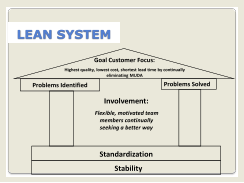 |
| Mark Doman offers insights from his blog “Doman on Lean.” |
I have always stressed the “people” part of lean in my courses. I devote several lectures to lean culture and the people value stream. The Lean System (from the design of the visual workplace to the use of lean tools, etc.) is focused on highlighting problems so that trained and motivated employees can work together to solve process issues and continuously improve performance.
 That’s how lean companies produce the highest quality at the lowest cost with the shortest lead time for their customers. Their employees are flexible, motivated team members continually seeking a better way.
That’s how lean companies produce the highest quality at the lowest cost with the shortest lead time for their customers. Their employees are flexible, motivated team members continually seeking a better way.
I’ve come to the conclusion that the first step in the people side of lean is the TEAM organization structure. Lean is not an individual sport. It is a team game. It’s ironic that we really understand and buy into team structures and teamwork when it comes to sports such as football, basketball and NASCAR racing; but we forget about its importance when we walk into work on Monday mornings.
The best lean companies start with teams. And those teams strive to be like the lightning-fast NASCAR pit crews that know exactly what to do (standardized work) and work constantly to eliminate any waste/MUDA from the process (kaizen) so everything they do is value-added work. The pit crews practice over and over to remove any waste from the process so that they can execute their roles perfectly and as fast as possible under pressure in their pursuit of team victory.
Lean companies start with teams as their basic organizational building block. They recruit and hire people who work well on teams and are flexible. They have team goals and their compensation systems have a big team component. Their training and development is all based on team and starts with the team leader.They emphasize teamwork and team problem solving — just like the NASCAR pit crews.
The NASCAR pit crew should be the model for the frontline work team and throughout the organization. Six to seven team members who know their respective roles inside and out and are cross-trained to know everybody else’s role on the team and are ready, willing and able to jump in at a moment’s notice to fix a problem.
If the “norm” for your organization is a traditional top-down, “I’m the manager, you’re the employee,” command and control type of organization structure, it’s hard to sustain a lean transformation. Employees don’t feel like team members and are less willing to identify problems and “go the extra mile” to fix a problem. They are waiting to be told what to do. If the line goes down, they get a rest until someone else fixes it. In a lean company, that’s when the team really jumps into action and they know exactly how to respond just like the NASCAR pit crew.
Teams, team members, team leaders, teamwork and team problem solving — that’s the heartbeat of lean. People like to be a valued member of a team. It’s not peer pressure, it’s team pride that motivates them to do what it takes to win. And in this brutal global marketplace, that’s what it takes to survive and prosper.
Mark S. Doman is a Pawley Professor in Lean Studies at Oakland University in the Human Resource Development Department and a member of the leadership team at the Pawley Lean Institute. Prior to joining Oakland University, he had 25 years of business experience with Ford and AT&T, where he held various executive positions in operations, human resources and legal. He has led several major organizational change initiatives throughout his career that included Lean Workouts, quality circles, TQM, process re-engineering, kaizens and corporate restructuring. He is the author of “A New Lean Paradigm in Higher Education: A Case Study.” Quality Assurance in Education, Vol. 19 No. 3, 2011 and “How Lean Ready Are You?” Target, Vol. 28 No. 2, 2012. His email address is doman@oakland.edu.


